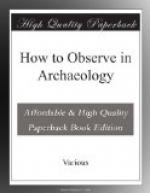III. Iron Age (Late Hittite).
To this belong the mass of ‘Hittite’ remains in Syria. Graves are unlined pits, with urn burials, the corpse having been cremated. Cylinders, &c., showing traces of fire, will belong to this Age.
Implements and weapons. Arrow-heads of bronze: spear-heads of bronze and iron: axes, knives, and picks of iron (miniature models occur in graves): daggers of iron. Fibulae, of bronze, semicircular and triangular (as in Asia Minor) (IX, Figs. 4, 9, 11): plain armlets of bronze: pins, spatulae, &c., of bronze: thin applique ornaments. Bronze bowls (gilt) with gadroon or lotus ornament (moulded) in later period. Steatite censers, in form of a cup held by a human hand, are not uncommon (IX, Fig. 7).
Pottery. Tall narrow-mouthed urns, bath-shaped vessels, and bell-kraters common (VIII, Fig. 10): trefoil-mouth oenochoae and hydriae; also amphorae (VIII, Fig. 7).
In earlier period, white or drab slipped surface with geometric patterns (rarely rude birds) in black. In later period, pinkish glaze with geometric patterns in black-brown, concentric circles being a common motive. Tripod bowls in unslipped ‘kitchen’ ware (VIII, Fig. 8). Blue or greenish glazed albarelli, with white, brown, or yellow bands, occur (as in Rhodes).
Figurines. Drab clay, painted with red or black bands and details. Two types: (a) Horsemen; (b) Goddesses of columnar shape, often with flower headdresses, and sometimes carrying a child.
Seals, &c. Scarabs with designs of Egyptian appearance: cylinders, steatite or (more commonly) glazed paste, lightly and often scratchily engraved: hard stone seals finely engraved: flattened spheroids in steatite with Hittite symbols on both faces, inscriptions being often garbled.
Inscriptions. Most of those in Hittite script, both relieved and incised, found in Syria, are of this Age, but chiefly of the earlier part of it (cf. Illustration VI). Those in Semitic characters begin in this Age; and to its later part (8th-7th cents.) belong important Aramaic inscriptions, e.g. the Bar-Rekub monuments of Sinjerli (Shamal). See tables of letter-forms appended to Palestine section, Illustrations X & XI.
IV. Persian Period.
Imported Egyptian and Egypto-Phoenician objects (bronze bowls as in Age III: scarabs: figure-amulets), Rhodian (pottery), Attic (coins, small black-figure vases, &c.).
Weapons and implements. Iron. Long swords: spearheads, socketed, often with square or diamond mid-rib: short double-edged daggers with round pommels: chapes (bronze) with moulded or beaten relief-work: knives, small and slightly curved: arrow-heads (usually bronze and triangular): horse-bits (usually bronze) with heavy knobbed side-bars: ear-rings, wire armlets and pins (generally plain) of bronze: fibulae as in Age III: circular mirrors, plain, of bronze: anklets of heavy bronze: kohl-pots, bronze, of hollow cylindrical form, with plain sticks.




